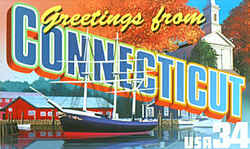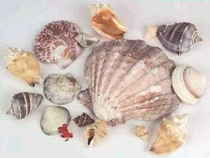
Connecticut Symbols
Connecticut State Shellfish
Eastern oyster

(Crassostrea virginica)
Adopted in 1989
The Eastern oyster was designated as the State Shellfish by the General Assembly in 1989. The oyster, which is a bivalve mollusk,
thrives naturally in Connecticut's tidal rivers and coastal embayments and is cultivated by the oyster industry in the waters of the Long Island Sound.
Oysters were consumed in great quantities by Connecticut's native American inhabitants, and early European settlers found oysters to be a staple and
reliable food source. The first colonial laws regulating the taking of oysters in Connecticut appeared in the early 1700's.
Oyster farming developed into a major industry in the State by the late 19th century. During the 1890's, Connecticut held the distinction of having
the largest fleet of oyster steamers in the world.
Today, Connecticut's oyster industry continues to thrive. Thousands of bushels of these delicious Connecticut-grown mollusks are marketed throughout
the country annually. Of all the shellfish species associated with the Connecticut shoreline, the oyster is by far the best known for its colorful
history, continued economic importance and esteemed reputation for quality.
Connecticut State Shellfish: Eastern oyster

Oyster shells are made of calcium carbonate (lime). The oysters must get this lime from the water they live in. They also have a sort of skin, called a mantle, which puts this calcium carbonate on the outside of their bodies to form a protective shell. Oysters must live in water that is temperate (warm all year) and not too cloudy. They grow only in areas where salt and fresh water mix together, like salt marshes. Oysters are born as free-swimming plankton (tiny microscopic organisms). When they grow up, they find a place (on mud, coral, debris, or other oyster shells) to attach and grow. Once they grow their shells, they can't move around anymore. When the tide is high, oysters are covered by water, but when the tide goes out, they are left sticking up into the dry air. Their shells close tightly together so the animal inside will not dehydrate (dry out) before the tide comes back in.
Diet
After spawning in early spring, the oyster loses a great deal of weight. This event usually coincides with the spring bloom of phytoplankton, their primary food source. Feeding is dependent upon water temperature; more food is consumed at higher temperatures than at lower. Oysters are filter-feeders. They suck in water and filter out the plankton and detritus to swallow. Then they spit the water back out. (Detritus is dead plant and animal matter.)
Reproduction
Reproductive organs can be readily observed only during the breeding season. There is no reproductive activity during the winter. Sexual maturity is a function of size rather than age. The first spawning usually occurs when the oyster is 2 years of age. Fertilization occurs when huge numbers of sperm sperm and eggs are expelled from the male or female and meet in the water.
Pearls
The oyster's mantle (skin) makes both an outer white crusty shell, and a smooth inner shell. The smooth inner part is called "nacre" or "Mother of Pearl." Sometimes a bit of sand gets inside the oyster's shell. This is very irritating to the oyster, like getting an eyelash in your eye. So the oyster covers this bit of dirt with shiny smooth Mother of Pearl. It keeps covering the dirt and rolling it around until it doesn't cause any more irritation. This makes a pearl. The oysters that people eat in north Florida (Eastern oysters) hardly ever make pretty pearls. But there are other kinds of oysters, clams, mussels, conchs, whelks, and even abalone that do make nice pearls. We think of pearls as being round and white, but they are often yellow or black, and many other colors and shapes.
Connecticut Law
The law designating the Eastern oyster as the official Connecticut state shellfish is found in the Connecticut General Statutes, Title 3, Chapter 32, Section 3-109c.
TITLE 3. STATE ELECTIVE OFFICERS.
CHAPTER 32. SECRETARY.
SECTION 3-109c. State shellfish.
Sec. 3-109c. State shellfish. The Eastern oyster, Crassostrea virginica, shall be the state shellfish.
(P.A. 89-321, S. 10, 12.)
Taxonomic Hierarchy: Eastern Oyster
Kingdom: Animalia
Phylum: Mollusca
Class: Bivalvia
Order: Ostreoida
Family: Ostreidae
Genus: Crassostrea
Species: C. virginica







